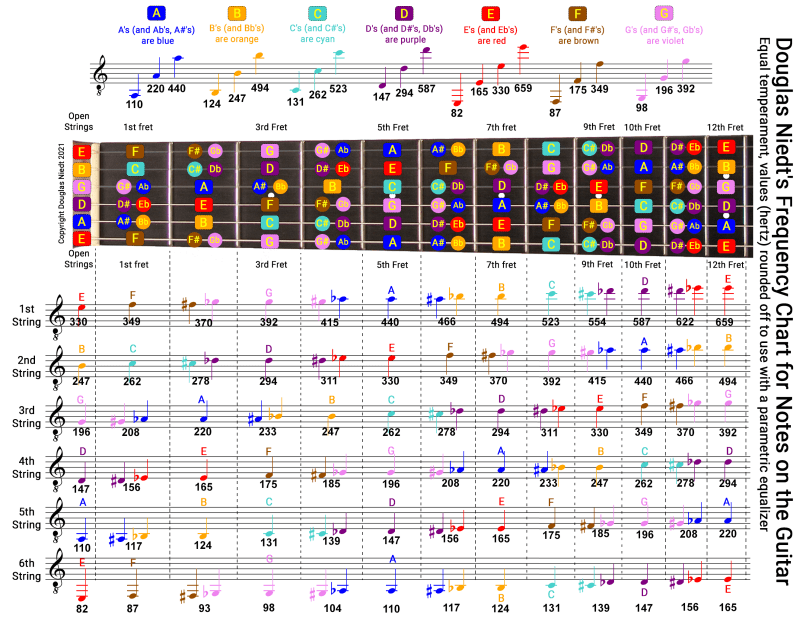FREQUENCY CHARTS FOR NOTES ON THE GUITAR
Why do I need a frequency chart?
A frequency chart is an indispensable tool to optimize your sound when amplifying your guitar. When you amplify a classical guitar, you will often find that As, Ds, Es, and some other notes sound louder or even boomy compared to other notes. You can fix that somewhat by moving the mic a little further away from the guitar or adjusting the basic tone controls on the amp. But a parametric equalizer is the best solution for fine control over particular frequencies. A parametric equalizer (and, to a lesser extent, a graphic equalizer) makes it possible to surgically isolate those notes and cut (reduce) their volume without affecting anything else.
Use these charts to improve your guitar's amplified sound. For example, if the A on the 3rd string 2nd fret sounds boomy in the performance space through your amplification system, the chart tells you the frequency of that note is 220 Hz. If you cut that frequency a few dB (decibels) on your parametric equalizer (or the general region on a 31-band graphic equalizer), it will often solve the problem. If it still isn't right, set the 220 Hz back to normal and try cutting the frequency an octave lower (220 Hz / 2=110 Hz). Or, cut the frequency an octave higher (220 Hz x 2=440 Hz). Cutting one of the three frequencies should solve the problem. For boomy notes on the bass strings, cutting the frequency an octave higher (multiply the frequency by 2) often does the trick.
I usually test the amplification system by slowly playing chromatic scales with "im" rest stroke from each open string to its 12th fret. If I am going to play pieces with drop-D tuning, I also test the 6th string D and D#. If any of my pieces use notes on the 1st string past the 12th fret, I also test those.
Go here for an in-depth discussion on equalization. You can skip through much of the highly technical information.
The equalizer is also a fantastic tool to eliminate problems with microphone feedback. For example, if you place the amplifier behind you, you will probably get feedback and need to use the equalizer to eradicate it. Cut the frequency or frequencies responsible for the feedback, and it is gone.
Frequencies of the notes on each string, open through the 12th fret in Hz (hertz)
Equal temperament, values rounded off for use with a parametric equalizer
Frequency Chart No. 1 for Notes on the Guitar in Table Format
6th string | 5th String | 4th String | 3rd string | 2nd string | 1st string |
|---|---|---|---|---|---|
E open=82 |
A open=110 |
D open=147 |
G open=196 |
B open=247 |
E open=330 |
F 1st fret=87 |
A# 1st fret=117 |
D# 1st fret=156 |
G# 1st fret=208 |
C 1st fret=262 |
F 1st fret=349 |
F# 2nd fret=93 |
B 2nd fret=124 |
E 2nd fret=165 |
A 2nd fret=220 |
C# 2nd fret=278 |
F# 2nd fret=370 |
G 3rd fret=98 |
C 3rd fret=131 |
F 3rd fret=175 |
A# 3rd fret=233 |
D 3rd fret=294 |
G 3rd fret=392 |
G# 4th fret=104 |
C# 4th fret=139 |
F# 4th fret=185 |
B 4th fret=247 |
D# 4th fret=311 |
G# 4th fret=415 |
A 5th fret=110 |
D 5th fret=147 |
G 5th fret=196 |
C 5th fret=262 |
E 5th fret=330 |
A 5th fret=440 |
A# 6th fret=117 |
D# 6th fret=156 |
G# 6th fret=208 |
C# 6th fret=278 |
F 6th fret=349 |
A# 6th fret=466 |
B 7th fret=124 |
E 7th fret=165 |
A 7th fret=220 |
D 7th fret=294 |
F# 7th fret=370 |
B 7th fret=494 |
C 8th fret=131 |
F 8th fret=175 |
A# 8th fret=233 |
D# 8th fret=311 |
G 8th fret=392 |
C 8th fret=523 |
C# 9th fret=139 |
F# 9th fret=185 |
B 9th fret=247 |
E 9th fret=330 |
G# 9th fret=415 |
C# 9th fret=554 |
D 10th fret=147 |
G 10th fret=196 |
C 10th fret=262 |
F 10th fret=349 |
A 10th fret=440 |
D 10th fret=587 |
D# 11th fret=156 |
G# 11th fret=208 |
C# 11th fret=278 |
F# 11th fret=370 |
A# 11th fret=466 |
D# 11th fret=622 |
E 12th fret=165 |
A 12th fret=220 |
D 12th fret=294 |
G 12th fret=392 |
B 12th fret=494 |
E 12th fret=659 |
Special Note: If you use a drop-D tuning (the 6th string tuned down to D, the open D is 73 Hz and D# at the 1st fret is 78 Hz.
DOWNLOAD THE CHART. When you print it, for best results, be sure to set your printer to LANDSCAPE mode, not portrait.
Frequency Chart No. 2 for Notes on the Guitar in Fretboard and Staff Layout

Special Note: If you use a drop-D tuning (the 6th string tuned down to D, the open D is 73 Hz and D# at the 1st fret is 78 Hz.
DOWNLOAD THE CHART. When you print it, for best results, be sure to set your printer to LANDSCAPE mode, not portrait.
